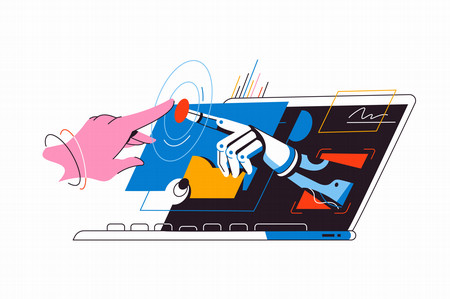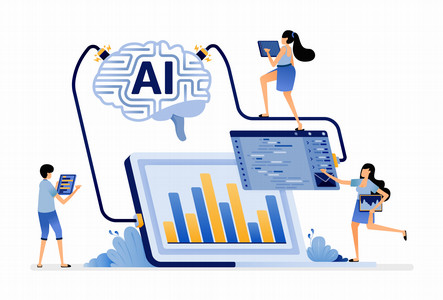Decoding the Impact of Generative AI on Teaching and Learning at UNF
The responses to this pivotal question are as diverse as they are intriguing. For some, this tool represents a potential threat to academic integrity and should be banned from learning environments, with firm restrictions implemented to prevent its use. Conversely, others see this technology as the inevitable future of many fields, viewing universities as the ideal places for students to learn how to utilize it for specific purposes. A third group may find themselves in the middle, grappling to fully understand what this tool is and the unique challenges and opportunities it presents.
This website has been developed with each of these perspectives in mind. We provide resources for those primarily focused on academic integrity and the establishment of clear guidelines; we offer tools for those eager to harness the power and potential of AI in their learning or teaching; we also cater to those simply wishing to expand their understanding of AI and its potential implications for education, aiding in the development of a more informed stance.
For those newly venturing into the realm of AI and its implications for education, a beneficial first step would be familiarizing themselves with key terms pertinent to this exploration. This list offers a foundational understanding of some of the most significant terms in this emerging landscape, along with examples of their applications.
Artificial Intelligence Definitions
Learn More...
Suggested Syllabus Language
Learn More...

FAQs
-
Using Generative AI Ethically
We've written suggested syllabus language for various perspectives, so there's something for instructors interested in using generative AI as part of their coursework and instructors looking to prohibit the use of generative AI.
You're welcome to use the language we've included on this page as part of your syllabus. -
Identifying AI-Generated Content
With recent advances in artificial intelligence, it's becoming increasingly difficult to distinguish between human-generated and AI-generated content. However, there are usually clues.
Here are some tips and tools for identifying AI-generated text:
- The Content is Inconsistent: AI-generated text might contain logical inconsistencies, abrupt topic changes, or an abnormal degree of repetition.
- The Content Lacks Depth: While AI can generate relevant content, it often lacks depth and insight because our varied perspectives on complex topics come from lived experience and human expertise.
- Unusually Poor Grammar and Syntax: Keep an eye out for unusual phrasing, grammatical errors, or the misuse of common idioms because generative AI works by assuming the next word in a sentence according to observed patterns. This reality means artificial intelligence gets language wrong sometimes.
- Fails Fact-Checking: AI generates content based on its training data and doesn't fact-check the information it generates. So, confidently stated misinformation may indicate artificially generated content.
- Fails Plagiarism Checkers: Turnitin initially claimed to identify AI-generated content with 98% to 99% accuracy; however, third-party reviews have revealed higher rates of false positives. Additionally, OpenAI (the creators of ChatGPT) admitted that they could not reliably detect the use of their software. Learn More about UNF and AI-Detection
- The Content is Inconsistent: AI-generated text might contain logical inconsistencies, abrupt topic changes, or an abnormal degree of repetition.
-
Examples of Generative AI
- Microsoft Copilot: Copilot currently generates text with OpenAI’s GPT-4 model and creates images using DALL-E 3. UNF is proud to offer Copilot with Data Protection, an enterprise-level AI tool from Microsoft for all UNF students, faculty, and staff.
-
ChatGPT-4: A more powerful variant of GPT-3, ChatGPT-4 is used to generate responses and create conversational agents or chatbots that can interact with students for tutoring or customer service purposes.
-
Artbreeder: This tool combines images to create new ones and can be helpful in fields like art, graphic design, and visual communications for generating unique visual content.
-
Jukin Media: This is a music generation AI useful in music and entertainment education for creating new tunes and understanding music composition./p>
-
Tensorflow Playground: A tool to understand and create neural networks. Although not strictly a generative AI, it’s a learning tool that offers hands-on learning about how AI works.
-
MuseNet: Developed by OpenAI, MuseNet can generate 4-minute musical compositions with ten different instruments and combine styles from country to Mozart to The Beatles, creating a novel tool for music education.
-
WriteWithTransformer: A tool by Hugging Face that can complete texts with the power of AI, offering a practical tool for writing and literature classes to generate ideas.
-
Grammarly: While not purely a generative AI, Grammarly utilizes AI to provide writing assistance, from checking grammar and punctuation to suggesting better ways to frame sentences.
-
Google’s Bard: Bard is a conversational generative artificial intelligence chatbot developed by Google, based initially on the LaMDA family of large language models and later the PaLM LLM.
-
Copy.ai: Copy.ai is an AI-powered tool that helps generate creative content, such as blog posts, marketing copy, and more. It can be helpful in communication, marketing, and business courses, offering students a chance to see how AI can assist in drafting professional content.
-
DALL-E: Created by OpenAI, DALL-E generates unique images from textual descriptions, providing a powerful tool for graphic design, art, and visual communication courses.
-
DeepArt.io: This tool uses AI to transform photos into works of art, mimicking the styles of famous artists. It can be a valuable tool for art, design, and digital media studies.
-
Runway ML: This creative toolkit uses machine learning models to aid in image creation, making it useful in a wide range of disciplines, from design to digital media.
-
This Person Does Not Exist: This website uses AI to generate realistic human faces of people who do not exist. It could be useful in digital arts, psychology, and sociology for discussing perception and reality.
-
Lobe.ai: This tool makes it easy to create machine learning models for visual recognition tasks, which can benefit computer science, data analysis, and engineering courses.
- Microsoft Copilot: Copilot currently generates text with OpenAI’s GPT-4 model and creates images using DALL-E 3. UNF is proud to offer Copilot with Data Protection, an enterprise-level AI tool from Microsoft for all UNF students, faculty, and staff.
Understanding Generative AI
Generative AI in Education
Benefits and Challenges of Generative AI
Generative AI at UNF

